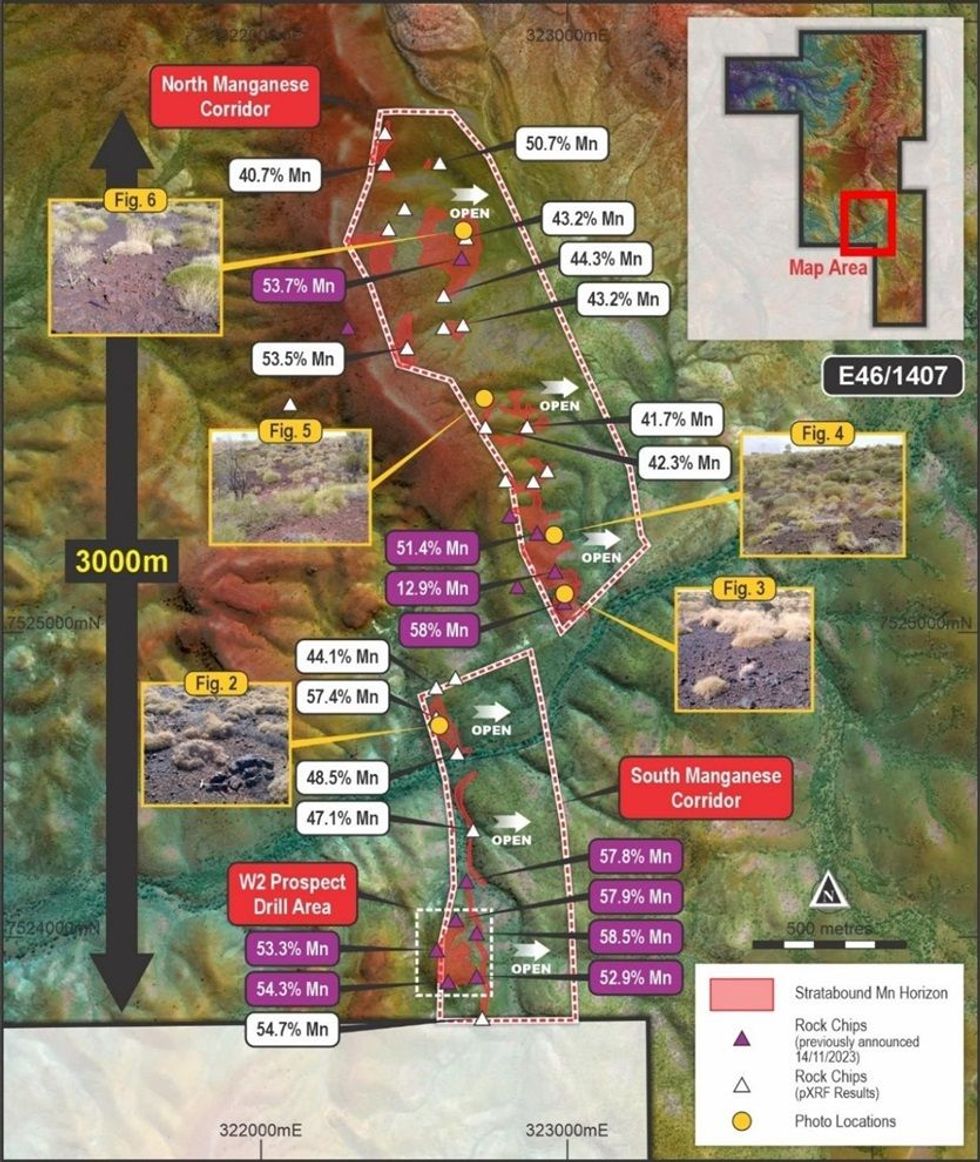
November 26, 2024
Australian manganese explorer and developer, Black Canyon Limited (Black Canyon or the Company) (ASX: BCA) is pleased to announce results from detailed mapping and pXRF analysis of rock chip samples undertaken within the manganese corridors at the Wandanya Project. The results show the scale potential of the manganese mineralisation discovered at Wandanya and potential for significant high grade iron formations, which had not been previously drilled or mapped prior to Black Canyon prospecting the targets.
- Detailed mapping and rock chip sampling completed over the Wandanya project following successful RC drill2 and previous rock chip sampling campaigns1.
- Portable XRF (pXRF) analysis confirms multiple widespread rock chip samples with consistently similar grades to the RC drilling completed at W2, ranging between 30 and 50% Mn.
- 3km overall strike of outcropping manganese mineralisation now confirmed with only 240m of this drill tested.
- Significant opportunity to expand the mineralised footprint with extensive manganese outcrops well exposed in multiple incised gulleys extending 150m cross strike and shallowly dipping to the east.
- Initial metallurgical testwork is underway to potentially produce a high-quality manganese concentrate for silico or ferro alloying and feedstock for high purity manganese sulphate (HPMSM) testwork.
- Additionally, rock chip sampling provided further evidence of widespread hematite enriched sediments that are similar to previously reported1 iron rich formations that assayed 63.3%, 63.1 and 57.6% Fe. The Company is awaiting laboratory-based iron XRF assays, as the preliminary pXRF results were beyond the accurate grade range of the pXRF
Cautionary Note in relation to visual estimates and pXRF readings: The Company cautions that visual estimates and pXRF readings should never be considered a proxy or substitute for laboratory analyses. Laboratory assays (XRF for Mn C Fe suite of elements) are required to determine representative grades of the elements associated with the visible mineralisation reported from geological mapping and pXRF readings. Further details are found within Appendix 1.
Rock chip samples have been submitted to Bureau Veritas in Perth WA with analytical results expected in early to mid-December.
Black Canyon’s Managing Director Brendan Cummins said:
“Following the successful recent RC drill program, detailed mapping and rock chip sampling assay results continue to impress. We are seeing strike extensive mineralisation along a 3km long corridor, which demonstrates the scale potential of this new and unique style of manganese mineralisation.
“Widespread outcrops and consistent high-grade manganese results from drilling and rock chip sampling are becoming a clear characteristic of the Wandanya discovery. In addition, we are eagerly awaiting the assay results from rock-chip sampling of the extensive hematite enriched iron formations also mapped in the area that look quite prospective.
“We look forward to returning with an RC rig in 2025 to further test these compelling targets along strike and down dip to determine their full-scale potential.”

W2 Prospect, Wandanya (BCA 100%)
The stratabound hosted manganese mineralisation has been traced along a 3km long corridor, is dipping shallowly to the east and remains open. The footwall and hangingwall units comprise of dolomite and calcareous siltstone respectively. The target manganese horizon is often well exposed by gulleys eroding through the hangingwall, forming continuous outcrops up to 150m cross-strike before the unit is overlain by shallow dolomite and cover sequences.
At the W2 prospect, only 240m of strike at a width of 200m has been drill tested with consistent grades and widths2 including:
- 5m @ 31.1% Mn from surface, including 2m @ 42% Mn (WDRC005)
- 6m @ 26.3% Mn from 4m, including 3m @ 40.1% Mn (WDRC021)
- 6m @ 2G.6% Mn from surface, including 3m @ 41.0% Mn (WDRC031)
- 6m @ 2G.2% Mn from 4m, including 3m @ 3G.7% Mn (WDRC032)
- 5m @ 32.4% Mn from 3m, including 3m @ 40.1% Mn (WDRC033)
To the west, multiple occurrences of hematite rich sediments were mapped and sampled, with the results from the pXRF readings exceeding the accurate range of the pXRF. Hence, these samples have been submitted to the laboratory and assay results will be reported when they have been received.
Click here for the full ASX Release
This article includes content from Black Canyon, licensed for the purpose of publishing on Investing News Australia. This article does not constitute financial product advice. It is your responsibility to perform proper due diligence before acting upon any information provided here. Please refer to our full disclaimer here.
The Conversation (0)
Latest News
Latest Press Releases
Related News
TOP STOCKS
American Battery4.030.24
Aion Therapeutic0.10-0.01
Cybin Corp2.140.00